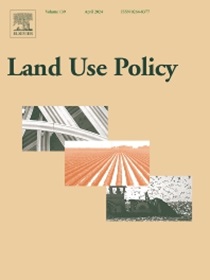Can urban vitality be seen? Video analytics of social interaction and land use
IF 5.9
1区 社会学
Q1 ENVIRONMENTAL STUDIES
引用次数: 0
Abstract
Social interaction is a powerful indicator of the vitality and quality of urban public spaces. In areas such as urban squares, the frequency, duration, and spatial distribution of interpersonal encounters reflect how effectively a space facilitates social interactions within the urban land system. However, these interactions—often brief and subtle—are difficult to observe and quantify in dynamic environments using conventional planning tools, limiting the proper management and design of urban spaces. To address this gap, this study proposes a human-centred, AI-based video analytic approach using computer vision techniques to detect and quantify social interactions. Interactions are classified into four categories—transient, sustained, long-term, and gathering—based on proximity and temporal thresholds, and are analysed in relation to spatial configurations, such as seating, greenery, and visual landmarks. A Social Interaction Intensity Index (SIII) is introduced to evaluate the capacity of different spatial zones to foster social activity, based on identified interaction points and their duration, normalized by area for fair comparison across zones. Rather than interpreting behaviour semantically, the index provides an objective and scalable indicator of how effectively urban land supports social functions and public life. This framework bridges data-driven sensing and human-centred land use policymaking, enabling planners and decision-makers to identify socially underperforming zones, guide spatial reconfiguration, and promote inclusive, evidence-based regeneration strategies that uphold humanistic values in public space design.
能看到城市的活力吗?社会互动和土地利用的视频分析
社会互动是城市公共空间活力和质量的有力指标。在城市广场等区域,人际交往的频率、持续时间和空间分布反映了一个空间在城市土地系统内促进社会互动的有效程度。然而,这些相互作用——通常是短暂而微妙的——很难用传统的规划工具在动态环境中观察和量化,从而限制了城市空间的适当管理和设计。为了解决这一差距,本研究提出了一种以人为中心的基于人工智能的视频分析方法,该方法使用计算机视觉技术来检测和量化社会互动。基于邻近性和时间阈值,相互作用被分为四类——短暂的、持续的、长期的和聚集的,并与空间配置(如座位、绿化和视觉地标)进行了分析。引入社会互动强度指数(Social Interaction Intensity Index, SIII)来评估不同空间区域促进社会活动的能力,该指数基于确定的互动点及其持续时间,并按区域归一化,以便在区域间进行公平比较。该指数不是从语义上解释行为,而是提供了一个客观的、可扩展的指标,说明城市土地如何有效地支持社会功能和公共生活。该框架将数据驱动的感知和以人为中心的土地利用政策制定联系起来,使规划者和决策者能够识别社会表现不佳的区域,指导空间重构,并促进包容的、基于证据的再生战略,在公共空间设计中坚持人文价值。
本文章由计算机程序翻译,如有差异,请以英文原文为准。
求助全文
约1分钟内获得全文
求助全文
来源期刊

Land Use Policy
ENVIRONMENTAL STUDIES-
CiteScore
13.70
自引率
8.50%
发文量
553
期刊介绍:
Land Use Policy is an international and interdisciplinary journal concerned with the social, economic, political, legal, physical and planning aspects of urban and rural land use.
Land Use Policy examines issues in geography, agriculture, forestry, irrigation, environmental conservation, housing, urban development and transport in both developed and developing countries through major refereed articles and shorter viewpoint pieces.
 求助内容:
求助内容: 应助结果提醒方式:
应助结果提醒方式:


